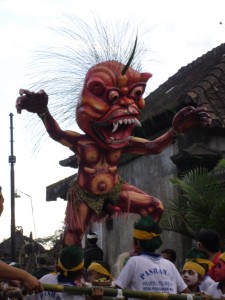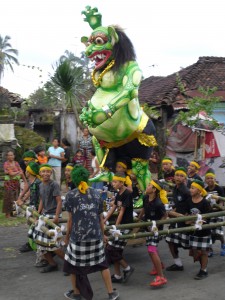The day before the Balinese “day of silence” is loud and frantic.

Oka (house mom), Jeanne (from Cali) and I dressed in our kabayas, sarongs, and sashes - ready for temple! (You can't get in without a sarong and a sash, and I'm sure it would be embarrassing for Oka if we showed up in anything but traditional shirts.
I accepted an invite to attend the morning temple ceremony with the mother of the family that owns the compound we’re living in. She dressed me in a sarong, kabaya, and sash. I discovered why Balinese women have such tiny waists — corsets! Once I was appropriately bound and teetering on too-small heels, we drove to the temple carrying a plate of offerings and vibrant flowers for prayers.
We passed through the elaborate temple gate and knelt on concrete prayer strips. I stumbled through a series of offerings, always pressing a new color of flower between the two middle fingers of my hands clasped in prayer. Water rained down on my head, sprinkled by an old woman dressed in white. I took three symbolic sips of holy water and used a fat yellow flower to splash water on my hair. I “washed” my hands in the smoke of the incense before being swept away to the community hall.
We, the attendees, sat behind the raised holy platform where the priests perched, dressed Egyptian-style — white robes, one shoulder bare, and wearing tall gold crowns. Men in the corner nearest us played xylophone-like instruments called gamelans. Clear hollow notes mixed with the din of voices and the crackling of the priests praying over the microphone. Men smoked cigarettes, worshipers pulled out camera and snapped photos, candy was passed through the crowd, and people discretely took cellphone calls.
We caught glimpses of the dances being performed in front of the priests – laughing older women casually winding amongst giant effigies of demons. Suddenly a louder voice came over the microphone and the din faded to nothing. I scrambled for the proper flowers and movements as the voice led the congregation in a prayer. Soon after we all got to our feet and the social hour began. My host introduced me to her mother — the queen of the village — a stunning seventy-year-old woman who didn’t look a day over 45 and whose poise was accented by posh Dolce and Gabbana sunglasses.
A few hours later my hosts – Oka (mom) and Putra (dad) — Jeanna the Californian and I were driving into the countryside to visit a healer.
I watched as Oka and Jeanne took turns under the Balian (healer’s) hands. He used holy coconut oil and tiger balm as he pressed points on the feet, areas of the belly, and particularly painful spots near the knee. When Jeanne cleared off the mat, my compatriots urged me to give it a try. I cringed, thinking of the shrieks and stunned cries I’d just heard, but it’s not every day you’re in Bali at a Balinese healer.
I started face up. After a few squeezes and pokes, the Balian put holy water in my eyes. The drops combined with my mascara to create an elixir that burned badly enough to distract me from the painful pressure points being squeezed on the under side of my toes. OW! I must have shrieked, writhed in pain, and sucked in a hard breath an average of once every four seconds. The Balian was casual, dealing out his torture between cigarette puffs. After massaging my quads, he then climbed up on them — a man at least my size — and poked his hand deep into my belly in what seemed like a search for my spleen.
I flipped over and had my calves, ankles, and hamstrings tortured. Then he crawled onto my legs, used his foot to crack every vertebrae in my spine, pulled his knuckles down my back in long sweeps, and mercifully flicked his hands above my body. Then I sat up, my back to this gifted man, and had lightening bolts race through my arms as he squeezed hidden pressure points. I cringed as he first massaged and the began to flick my temples fast and hard. After about twenty close range blows, it was time for the other side. In a last hurrah of healing pain, he massaged my neck before squeezing it — one handed — as hard as possible, until my neck gave way with a loud SNAP!
Did I feel better? Well, I certainly felt happy it was over! Was I healed? Hard to say. As I reflected on the experience and Putra went in for his turn, we heard drums in the distance. The long-awaited ogo-ogo parade was starting! Each village makes their own ogo-ogos — huge plaster demons on wire frames. The day before Nyepi (Balinese New Year – the day of silence), the demons are paraded around the village and then burned. I’d been seeing ogo-ogos everywhere, in various stages of construction, ever since my parents’ visit. I could wait to see what all this grandiose art was about!

My favorite ogo-ogo. It's one of the smallest ones handled by small children who all looked to be between seven and ten. So cute!
We ran to the street and saw huge figures up to 20 feet (7m) tall mounted on bamboo grids. Teens all dressed in matching t-shirts and sarongs, hair often dyed to match their demon, filled in every spot possible on the grid. Each gang of ogo-ogo carriers had accompanying musicians armed with cymbals, a gong suspended from a frame, and drums. The musicians were frantic, pounding their drums and smashing their cymbals together like heavy metal rockers — perfectly synchronized. Together they created a frantic, pulsating beat. The demon-carriers spun their figure in a well practiced dance, rushing at the crowd, pulling back, spinning wildly but not out of control. The energy ran high and infected every bystander. (I got an awesome video! See below!) Even the smallest children got in on the action, with their own miniature ogo-ogo and adorable, faltering steps.
When Putra finished his healing session and we drove back to town, the sounds of demon-scaring cannon fire followed us the whole way home. I wore a smile on my face and a glazed look, dizzy with the enormous volume of cultural experiences I’d fit into one day — a temple ceremony, a healer, and a once-a-year high-energy ogo-ogo parade! Bali is amazing! ♣
See more ogo-ogos, a blackberry on an offering plate, what everyone leaves behind at the temple, and the healer balanced on Jeanne’s quads – all here.







Twitter Facebook Google+ StumbleUpon Reddit Pinterest